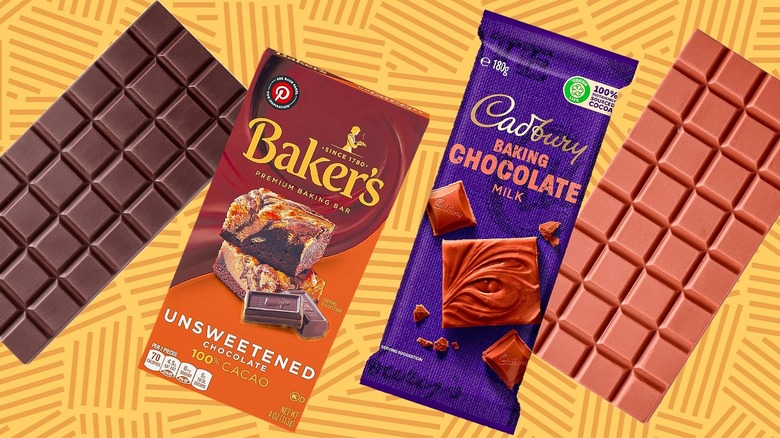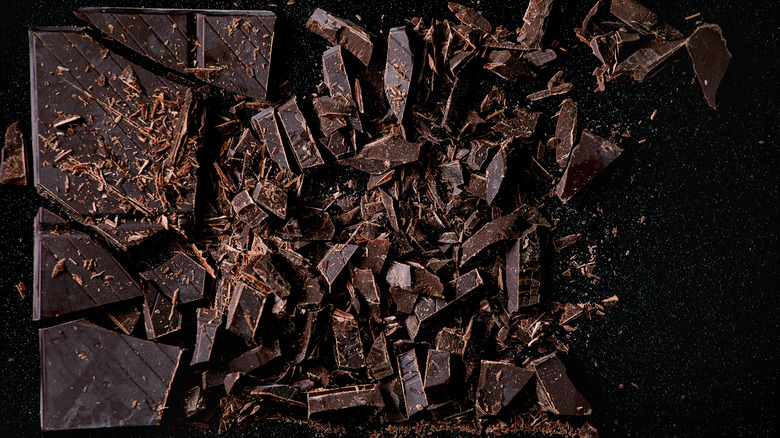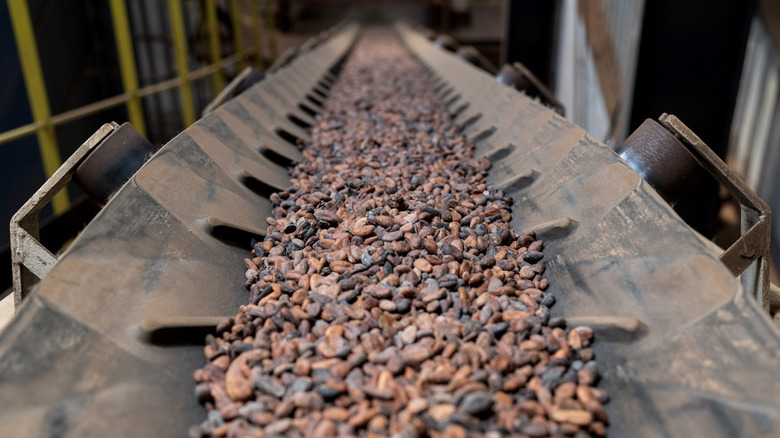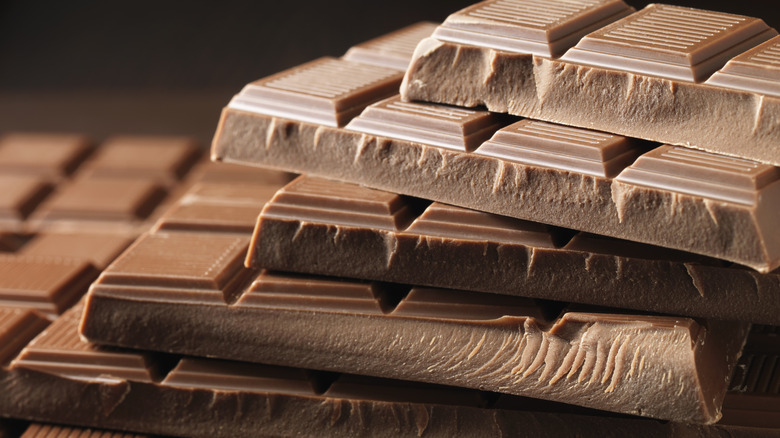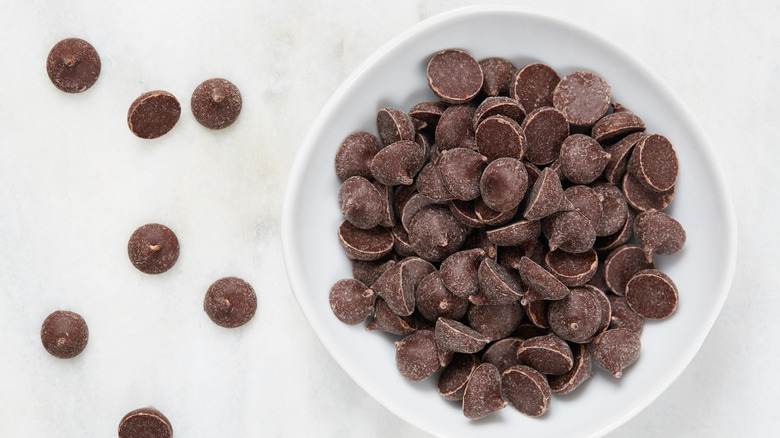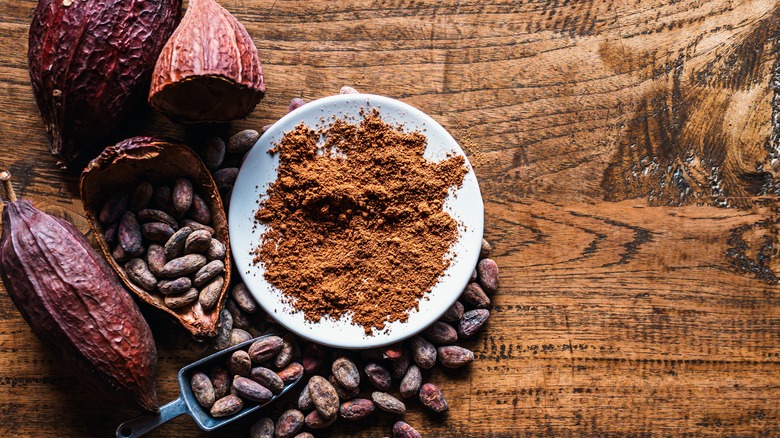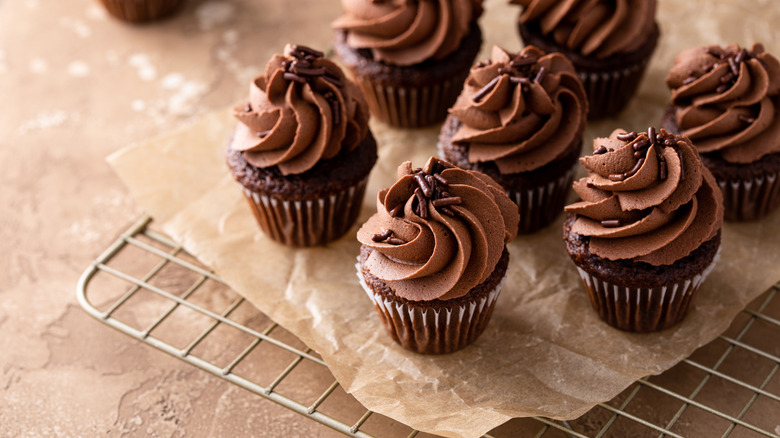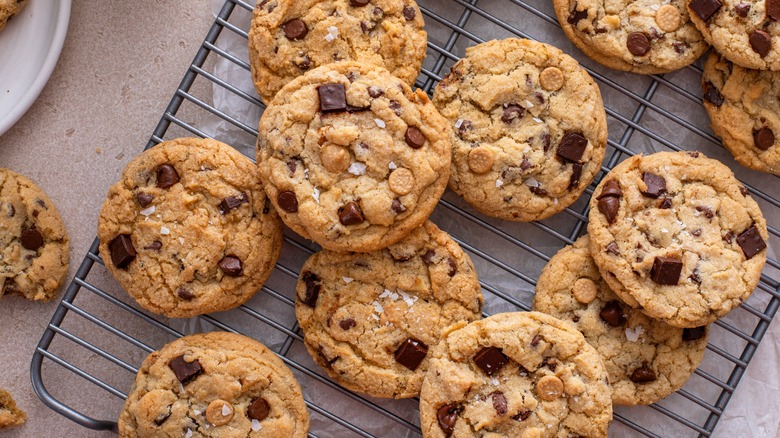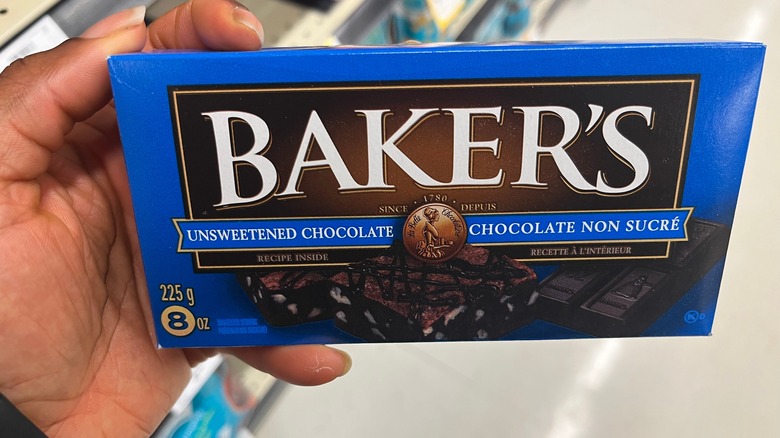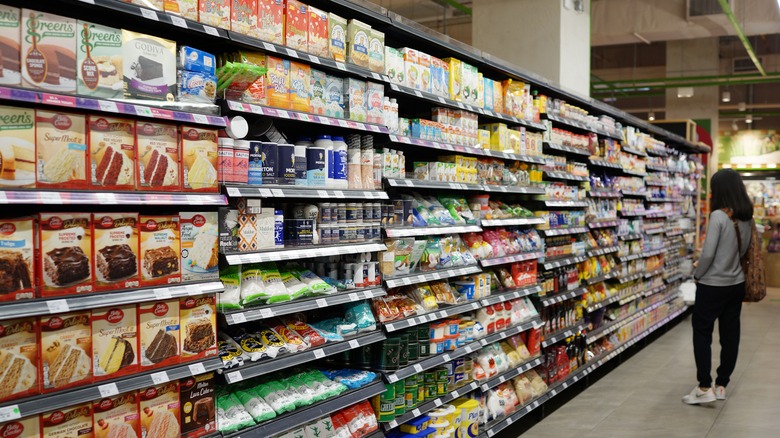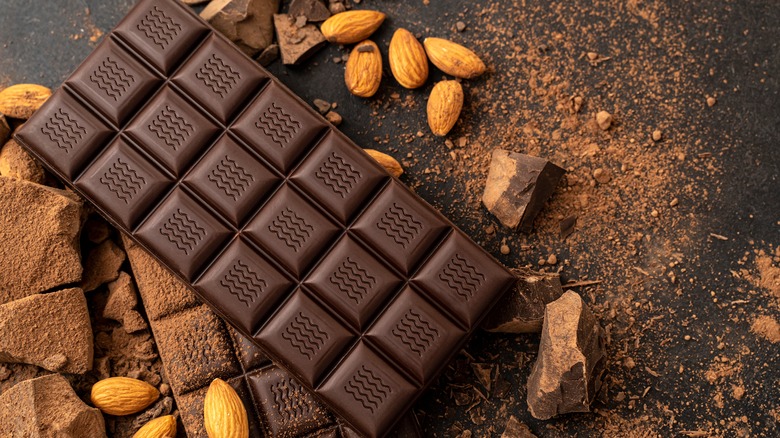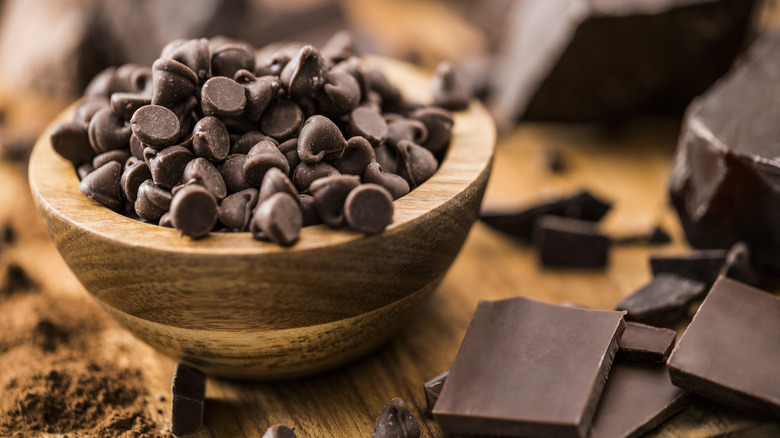What The Heck Is Baking Chocolate And How Do You Use It?
In the baking world, nothing behaves quite like you think it should. Ingredients like to misbehave; flour clumps, eggs curdle, and sugar burns. Basically, beginner baking mistakes happen when there's a lack of knowledge about techniques and ingredients. One of the elements that bakers tend to take for granted — and thus misunderstand — is chocolate. A complex blend of roasted, ground cacao beans, cocoa butter, sugar, and, occasionally, dairy, chocolate brings a lot of elements to the already complicated baking process.
That's where baking chocolate comes in. This specialty product was designed to take into consideration how chocolate changes once melted and baked into bars, cookies, cakes, and pies. Not typically enjoyed on its own, you won't find these bars nestled within the other candy-wrapped treats. But what sets them apart from the rest? And how on Earth should you use them for baking?
I'll be your baking chocolate expert today. As the former managing editor of a baking magazine, I've written numerous guides to every kind of chocolate you can find in the grocery store. I've also learned firsthand the ins and outs of chocolate from baking hundreds of brownies, chocolate chip cookies, and ganache-covered cakes in my time.
What is baking chocolate?
Simply put, baking chocolate is a confection that has been formulated with the baking process in mind. Like other chocolate, baking chocolate is made of cocoa butter and cacao powder, but the quantities used make all the difference.
For instance, it has more cocoa butter than the typical chocolate bar or chip, which helps it melt better and thus blend better into batters. The other change in ingredient ratio lies with the sugar. Baking chocolate will have less or, in some cases, no sugar, which is key to aiding a baker in not overloading the baked good with saccharine sweetness. Another bonus to having less sugar to work with is that the chocolate is less likely to burn when subjected to the high heat of the oven.
Then there are also the things that baking chocolate cuts out entirely. It will often eschew flavor additives, like vanilla extract or almond, to keep the taste of pure cocoa. It'll also ditch the stabilizers and preservatives often found in chocolate chips, which lets the plucky chip keep its pointed shape. A good baking chocolate should only list typical chocolate ingredients like sugar, cacao, and cacao solids. If soy lecithin is mentioned, know that it is an emulsifier commonly used by chocolatiers to make better melting chocolate.
How is it made?
To make a bar of baking chocolate, everything begins with the cacao bean. Once fermented, dried, roasted, and ground, the cocoa bean goes through a process known as conching, which mashes and heats it into a paste called chocolate liquor, a smooth blend of cocoa powder and cocoa butter. Solid at room temperature, this is essentially a bar of unsweetened chocolate.
From here, it can be incorporated with all the usual suspects, like extra cocoa butter (the naturally occurring fat in cocoa beans) and sugar (the sweetener that makes bitter chocolate palatable). This is usually where baking chocolate and all other types of chocolate part ways. For instance, milk chocolate will have milk solids/powder added in, which makes the overall taste and texture of the chocolate go mind-numbingly creamy. A commercial bar of chocolate will get extra sugar and maybe a shot of vanilla or artificial vanillin to round out the flavor.
Baking chocolate, on the other hand, stays relatively pure. It will either be now sold in its unsweetened state or have small amounts of sugar and cocoa butter added in to create bittersweet, semi-sweet, and dark chocolate variations.
Baking chocolate vs candy chocolate bars
Baking chocolate is generally made up of the same ingredients that regular chocolate bar is made up of but, again, what separates the two is the amount of each of those ingredients. Generally containing more sugar and flavor additives, candy chocolate bars should be treated just as their name indicates: like candy. They act like more of a mix-in rather than an ingredient you can melt and smoothly incorporate into your batters and doughs. Let's break down some of the specific candy bars you may see and how they differ from baking chocolate.
First, consider milk chocolate. As the most popular variety of chocolate out there, it tends to be reserved for enjoying all on its own as the balanced blend of sugar, milk, and cocoa makes it perfectly palatable alone. But these very same ingredients can act up in the hot oven. As mentioned before, a higher amount of sugar can lead to burning, and the milk solids are also vulnerable to taking on an overly toasted flavor.
White chocolate candy bars behave particularly differently, as they contain zero cocoa powder, and only use a blend of cocoa butter, milk, vanilla, and sugar. Heck, some people claim white chocolate isn't even chocolate. In fact, white chocolate has such a high amount of cocoa butter and milk solids, that it's frequently prone to seizing and burning when heated. Because of this, white chocolate is particularly difficult to bake with.
Baking chocolate vs chocolate chips
Chocolate chips happen to be the main ingredient in America's favorite cookie, but that doesn't mean it works well in other baking projects. One of the key problems with chocolate chips is that they come equipped with chemical stabilizers (often soy lecithin) to help them keep their shape even in a piping-hot oven. This is a lovely element in cookies and brownies but makes it particularly difficult to turn them into a uniform melted chocolate puddle you can incorporate into your batters and dough. It also can make for a chunky ganache or chocolate icing.
Inversely, baking chocolate can easily be used in chocolate chip cookies. Chopped and folded into the cookie dough, the only difference would be that the chocolate will melt into pretty puddles on top of the cookie. Once cooled, it will solidify again and work almost identically to the chocolate chip. In that way, I think baking chocolate is the more versatile and useful ingredient.
Baking chocolate vs cocoa powder
Unlike all the other ingredients previously listed, cocoa powder contains no cocoa butter, sugar, or really anything other than finely ground cacao solids. Before mixing into their batter, bakers often bloom their cocoa powder with hot water, coffee, or melted butter. Why? The hot liquid helps release some of the latent flavor compounds in the cocoa. When mixed with melted butter or oil in particular, the cocoa powder-fat blend can work in a similar way as baking chocolate, as that key addition of fat makes it a smoother, richer product perfect for mixing into your doughs and batters.
Of course, all baking chocolates rely on cocoa butter as its fat, so a butter- or oil-bloomed cocoa powder combo will still impart a different flavor and texture. For instance, cocoa butter has a lower melting point than butter and it is 100% fat, rather than butter's 80% to 82% fat content. With that in mind, a brownie made with baking chocolate rather than cocoa powder and butter could be the richer bar. Butter also has a distinctly milky flavor, while cocoa butter has no taste. Meanwhile, cocoa butter is solid at room temperature, while oil is liquid, so they have a different effect on your baking as well. Instead, consider vegetable shortening to be the closest dupe for cocoa butter's rich chemical makeup, as it's 100% fat, solid at room temperature, and basically has no flavor.
Using baking chocolate in your baked goods
Though baking chocolate has been essentially formulated to make your job easier as a baker, there are still some basic guidelines you need to follow to make the most of its unique qualities. The first step is to make sure you're melting your baking chocolate properly. That low melting point of cocoa butter that makes chocolate melt in our mouths also makes it burn twice as easily on a hot stove or when nuked in the microwave.
To avoid this, bakers should melt their chocolate in one of two ways. First, if the chocolate is not already in small pieces or wafers, it should be chopped into smaller chunks. This aids in even melting. Second, bakers can either microwave their chocolate in short 30-second increments, stirring in between each interval or melt it on the stovetop using a double boiler, stirring occasionally. The gentle, indirect heat of the double boiler helps keep the chocolate from scorching.
During this melting process, it's important to make sure no water or moisture finds its way into the chocolate, as this will cause it to seize. There is an easy way for you to fix seized chocolate, but it's best not to have the problem in the first place. Once melted and smooth, your baking chocolate can be folded into your batters and doughs with ease.
Using baking chocolate in your ganache/chocolate icings
Baking with chocolate can seem complicated enough, but how does one turn it into a beautiful creamy, dreamy frosting? A lot of simple chocolate buttercream recipes rely on cocoa powder to give it a hint of chocolate flavor. But richer, fudgier frostings can be accomplished with our pal baking chocolate.
As most frostings or icings use powdered sugar as their sweet backbone, unsweetened baking chocolate is often selected to keep the base recipe from going too saccharine. Once gently melted using the 30-second microwave or double boiler method, you can whip your slightly cooled chocolate into a basic buttercream recipe for maximum chocolate flavor. Sweetened baking chocolate can also be used, but I suggest using one that is on the bittersweet side so that your frosting doesn't go too sweet.
Then there is ganache, the chocolate and heavy cream-based topping that has the thick and velvety texture of a truffle. Sweetened baking chocolate is almost always used to make ganache, as just heavy cream rounds out the ingredient list. There are plenty of ways to make ganache, but to keep the chocolate from scorching, most bakers will heat the heavy cream to the point of steaming before pouring over the chopped chocolate. The residual heat from the cream will then melt the chocolate without the possibility of scorching. Use this ganache to fix a cracked cheesecake or fill a pie shell.
When NOT to use baking chocolate
Although baking chocolate is an extremely versatile ingredient, there are times that it won't work in your baking. Obviously, if you want to enjoy the classic look and feel of chocolate chips, you should opt for the original and not use baking chocolate. You may prefer to use chips in some of your other baking projects, like seven-layer magic bars or blondies, so consider keeping your chips here as well.
The other time to avoid using baking chocolate is when you're simply looking to dip or coat your baked goods. If you want to, say, cover a bunch of strawberries in chocolate, you don't need baking chocolate to get the job done. In fact, the stabilizers in chocolate chips make them particularly good for chocolate dipping, as they set up firmly on the surface of fruits, cookies, and more. Similarly, if you're looking to dip large batches of cake pops or the like, you may want to reach for candy melts, which can taste like chocolate but can withstand the heat better thanks to its waxy finish.
Different types of baking chocolate
The most classic version of baking chocolate available is the unsweetened type, which is offered by brands like Baker's, Guittard, and Ghirardelli. These will often be sold in 4- or 8-ounce packages of bars or squares, perfect for chopping up and melting down.
For those looking to get a great baking chocolate that also packs a little bit of sweetness, you also have bittersweet and semisweet baking chocolate varieties on the market. Bittersweet baking chocolate borders on dark chocolate in terms of flavor, offering more cocoa bite. Meanwhile, the semisweet chocolate packs more sugar, so will make your overall baked good taste sweeter too. These kinds of baking chocolates can come as bars, wafers, chunks, and féves, or flat, wide disks.
Bakers be warned: Some companies have started to slap the term "baking" on the assorted chocolate chips, milk chocolate, and white chocolate. You should be wary of considering these types of chocolate to be true baking chocolates. Your best bet to determine whether it'll work in your recipe is to read the ingredients and see if anything funky stands out.
Where to find baking chocolate
Baking chocolate will be hiding in the most obvious of places: the baking aisle of your local grocery stores. The most commonly found baking chocolate is Baker's, Ghirardelli, and Guittard, which all have various unsweetened and sweetened options for you. If you'd like to try an imported version of baking chocolate, you can troll around online to find numerous options.
Valrhona, a French brand, sells some of the highest quality baking chocolate in their signature féve shape, though you can expect it to fetch a much higher price than your typical grocery store options. King Arthur Baking Company also sells some Valrhona chocolate under its label. Taza and Callebaut also offer some options, with the former offering giant bags and the latter offering enormous one-pound chocolate blocks. One friendly note on ordering chocolate online: make sure you expedite the shipping in the warmer months so you're not greeted with a melted surprise.
How to properly store baking chocolate
The two main enemies of chocolate in terms of storage are heat and water. Heat obviously causes chocolate to melt, while water or any dampness can cause your chocolate to "bloom," which translates to unattractive light blotches on its exterior. Neither of these will necessarily affect the flavor of the chocolate, just the appearance. Storing your chocolate in the refrigerator will help with the first problem, but not the second.
Unless it's a fancy humidity-controlled unit, most fridges have a basic moisture level, so chocolate tends to bloom in there. Chocolate is also extremely sensitive to other odors and flavors, so if not tightly wrapped, can pick up the many aromas lurking in your fridge.
The best option for storing your baking chocolate is to place the chocolate tightly wrapped in a cool, dry place, far removed from odorous items like onions or curry powder. Once opened, do your best to use it as quickly as possible, as all chocolate tends to spoil faster when opened. In fact, try to think of your baking chocolate as similar to a produce item, like milk or eggs, which can only last so long without spoiling. When in doubt, wait until you know you need the ingredient, then buy the exact amount you need.
Substitutions for baking chocolate
So you still want to bake a beautiful treat but don't have the perfect baking chocolate on hand? Don't worry, there's a substitution waiting in the wings for you. As mentioned before, cocoa powder blended with vegetable oil or butter can mimic baking chocolate at its most basic level. If your recipe calls for unsweetened baking chocolate, simply mix one part butter with three parts cocoa powder. Butter will definitely produce a different flavor, as it has milk fat, but it should still work, just know that it has a bit more water to it than if you used the oil.
If your recipe calls for bittersweet or semisweet baking chocolate, feel free to use traditional chocolate bars. The dish probably won't have as luxe of a texture or flavor, but it should still be a perfectly delicious baked good. As a last-ditch effort, use chocolate chips, although this will produce the least satisfying of results thanks to the presence of excess sugar and chemical stabilizers.
All in all, do yourself a favor and give baking chocolate a try. It could completely change the way you look at a chocolate chip or bar.
